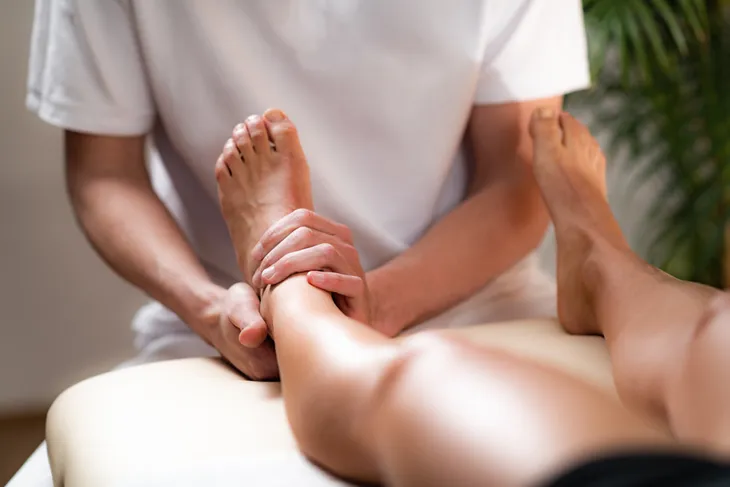- Rheumatoid arthritis is an autoimmune disease that can affect the joints in your foot and ankle.
- RA in the foot can cause inflammation, swelling, and painful symptoms.
- Luckily there are a variety of strategies you can try to help relieve RA-related foot pain.
- In some cases, surgery may be necessary.
Rheumatoid arthritis is an autoimmune and inflammatory disease that causes your immune system to attack healthy cells. When rheumatoid arthritis affects the joints in your foot and ankle, it causes inflammation, swelling, and painful symptoms. In some cases, the pain can be so severe that even wearing shoes can be unbearable. The good news is you can manage your foot pain by keeping your rheumatoid arthritis under control.
Why Does Rheumatoid Arthritis Cause Foot Pain?
Rheumatoid arthritis can cause inflammation in many joints of the body and the feet are no exception. The American Academy of Orthopaedic Surgeons (AAOS) explains that rheumatoid arthritis causes overactivity in the lining that covers your joints, called synovium. This results in swelling, and inflammation. Over time, the joints, ligaments, and other tissues that support the foot become destroyed which can lead to pain.
The source also notes that weakened ligaments can cause joint deformities. Some common deformities of the foot include claw toe or hammertoe.
Non-Surgical Ways to Manage Foot Pain
Foot pain can not only be debilitating but it can seriously disrupt your day, preventing you from accomplishing your daily tasks. The good news is there are strategies available that can help manage the pain.
While some individuals may require surgery, there are non-surgical methods that can help relieve the pain. However, factors such as overall health, age, and lifestyle will ultimately determine if non-surgical or surgical methods are right for you. This is why it’s important to work with a specialist. First, let’s take a look at some non-surgical methods to relieve rheumatoid arthritis-related foot pain.
Invest in Good Shoes
One critical step in managing foot pain caused by rheumatoid arthritis is by investing in good shoes. High heels or narrow-toe shoes will wreak havoc on your feet, making the pain even worse. This is because they “cause the wearer to put pressure on the ball of the foot and can cause marked deformities,” explains Everyday Health.
The source says when shopping for shoes you should look for a pair that has a low heel, wide toe, and good arch support. This will help distribute your weight evenly on your foot. Investing in orthotics may also help relieve foot pain.
Wear Shoes Indoors
Do you typically leave your shoes at the front door and walk around your home barefoot? If you have rheumatoid arthritis you may want to reconsider.
According to Health Central, “For most people with RA-related foot pain, going barefoot can cause more pain.” Try wearing supportive shoes or sandals indoors and see if your foot pain improves. Investing in good indoor shoes is just as important as outdoor shoes.
Change Your Exercise Routine
Exercise is a vital part of a healthy lifestyle. It helps keep your joints mobile, your muscles strong, and as you get older, regular exercise can help you keep your independence. That said, those with rheumatoid arthritis-related foot pain may need to make some exercise adjustments.
Rheumatoid arthritis sufferers may benefit from low-impact exercises such as swimming, cycling, and walking. These types of exercises can still strengthen your muscles and joints but without putting too much pressure on your feet. You may also want to work closely with a physical therapist to learn what exercise routines you can follow that won’t enhance your foot pain.
Take Care of Your Feet
Do you have an intensive skincare routine? How about applying moisturizer to your hands? When it comes to self-care, the feet often get neglected. But the fact is, taking care of your feet is an important step in helping relieve (and even prevent!) foot pain.
For starters, you can give your feet a foot bath and massage regularly. These can be done at home or by a professional. Massaging your sore feet can help relieve pressure and soothe pain whereas a warm foot bath can help relieve stiff joints which we’ll get into more detail next!
Cold and Hot Therapy
The Arthritis Foundation says hot and cold therapies may be beneficial for rheumatoid arthritis-related foot pain too. Warm baths or heat pads can help soothe stiff joints, while cold therapy is best for acute pain and swollen joints, says the source. Cold and warm foot baths can also help stimulate circulation in the foot.
Cheryl Crow, an occupational therapist, tells Health Central that wrapping your feet with frozen pea bags and a thin towel for 15- to 20-minutes can do the trick. Crow says to allow your skin to return to normal temperature before applying ice again. You can also make your own cold bath by filling a bucket with ice and water. When using hot therapy, you can apply hot packs to your inflamed foot and joints or you can soak in a hot bath.
Massage Ball
Does your foot pain radiate from the bottom of your foot? Foot pain located on the heel, ball, or arch may be relieved by massaging the area with a tennis ball or spiky massage ball, says Health Central.
“Massage helps release the muscles around your tender joints and allow more blood to flow to them,” explains the source. Foot massages can help provide immediate relief, however, the source says some research suggests that a massage can have a therapeutic effect, and may reduce inflammation in other parts of the body as well.
Avoid Standing All Day
Accessing your daily habits is also an essential part of foot pain management. Does your job require you to stand all day? Or perhaps you choose to be up on your feet. Whatever the case, those with rheumatoid arthritis-related foot pain should try their best to avoid standing all day.
Standing for long periods of time can put added pressure on your feet which can lead to more pain. Instead, do your best to alternate your activities so you can sit for parts of the day and stand for others. If there’s no way to avoid standing while at work, at the very least you should invest in a good pair of supportive shoes.
Maintain a Healthy Weight
Maintaining a healthy weight is important for your overall health. It can help lower your risk of heart disease, stroke, diabetes, high blood pressure, and many different types of cancers. It turns out, maintaining a healthy weight can also help reduce foot pain caused by rheumatoid arthritis.
Everyday Health says, “The more you weigh, the greater your risk of foot joint pain with or without rheumatoid arthritis.” To find out what a healthy weight is for you, talk to your doctor. Your doctor can work with you to find your ideal weight and help provide tips to get there.
Work With a Podiatrist
Along with managing your foot pain at home, it’s also beneficial to work with a podiatrist. Podiatrists are medical specialists who can help treat an array of injuries and complications in the feet and lower legs. Your doctor may even refer you to one.
A podiatrist can help you find the best orthotics for your shoes. While they can be expensive, some may be covered by health insurance. They may also recommend a splint or brace. Arthritis Health says these can help stabilize the foot and decrease mild to moderate pain.
Physical Therapy
A physical therapist can also help you manage your foot pain. Arthritis Health explains that physical therapy can help “stretch and strengthen the joints in the foot and ankle and improve joint function.” The source also notes that physical therapy may also help decrease your risk of future deformities in the foot.
To find a reputable physical therapist near you, contact your doctor and they may refer you to one. You can also search online, read reviews, or talk to friends and family for recommendations. Health Central notes that physical therapy sessions may cost around $150, however, prices will vary depending on where you live. It’s also worth looking into if your health insurance will cover (or partially cover) your sessions.
When Is Surgery Necessary?
In some cases, surgery is needed to help alleviate pain. This is especially true if you can’t walk without pain. Arthritis Health also notes surgery may be necessary if foot and toe deformities (such as bunions, hammertoes, and nodules) can’t be managed with supportive shoes or braces.
There are different types of surgery available, such as fusion, resection, and joint replacement. The goal of surgery is to help fix the physical deformity, improve foot function so that walking and standing are comfortable, and, of course, relieve foot pain. Your doctor will decide which type(s) of surgery are best suited for your case but ultimately, it’s up to you if you want to have the procedure. Work with your doctor to weigh the pros and cons of surgery.
















